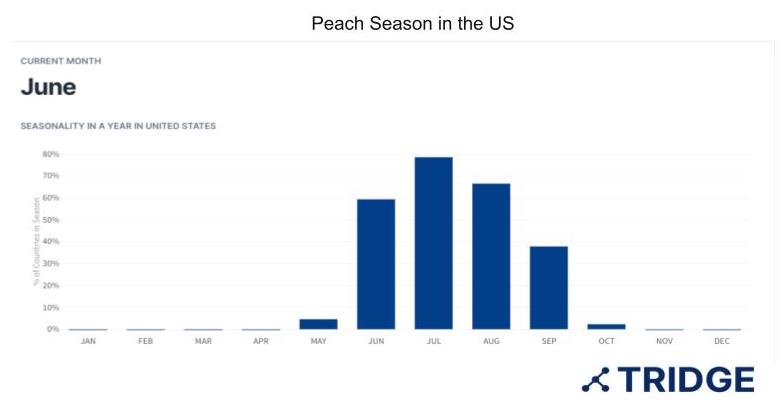California’s peach production is projected to increase in the coming season
The United States grows two basic varieties of peach - clingstone and freestone. In clingstone peaches, the flesh “clings” to the "stone" of the peach, which makes it difficult to separate, and they are more suitable for processing. The freestone variety" freely" separates the pit from the flesh, making it ideal for fresh consumption. The total peach production in the US stood at 617.76 thousand tons during 2020. The peach season begins in May and goes on till the month of September. The production peaks in July, with maximum farmers harvesting their crop. Peaches were commercially produced across 20 states of the country, with California, South Carolina, Georgia, and New Jersey as the top four states. California supplies more than 50% of the US’s fresh peach crop and more than 96% processed peaches.

Source: Tridge.
California’s 2021 peach crop production is forecast to increase by 3%, from 468 thousand tons in 2020 to 480 thousand tons in 2021. During the entire growing season, the weather conditions were ideal for the blooming of the peaches with adequate heat and water through irrigation. While the California Freestone crop is forecasted at 240,000 tons, 9% more than the previous season, the Clingstone crop is projected to be 3% less than 2020. The blooming occurred a week earlier than usual in 2021, increasing chilling hours in growing areas. The increased chilling hours are likely to improve the quality of the harvested fruit.
There is a shortage of agriculture laborers and workers in California, which reduced the thinning of peach plants. The thinning process is ideal for a good harvest as it removes some parts of plants to make room for the growth of peaches. However, lack of thinning has resulted in smaller size peaches being harvested. As the peach season began in June, there was a surplus of peaches of smaller sizes like 54/56, which also tend to fetch lower prices.
According to Rajjun Sahota, Country Manager at Tridge, peach and nectarine prices in the US were relatively high as the season started by the end of May. The price volatility is pretty standard during the opening month of the season in the U.S. It is expected that the prices will continue to fall as more fruit reaches the market by trending downwards through June and bottoming out in July. The prices will likely start increasing by September for peaches as their season ends.
Sources
- The Packer. “Good crop of California stone fruit expected.”
- Tridge. Local Insights. “California labor issues effect peach and nectarine sizes.”
- Tridge. Local Insights. “US peach and nectarine prices trending downwards.”
- USDA. Crop Production.



